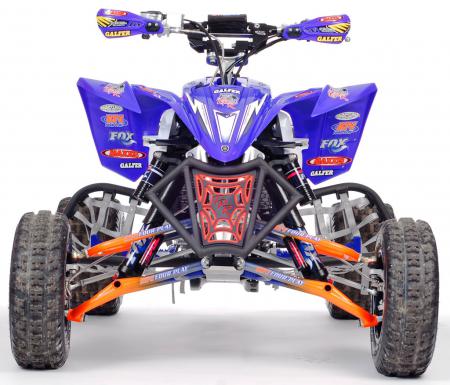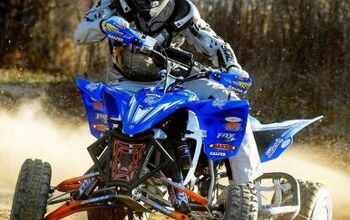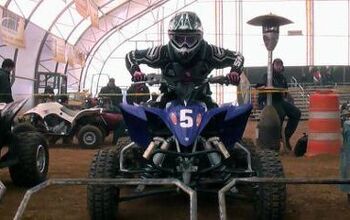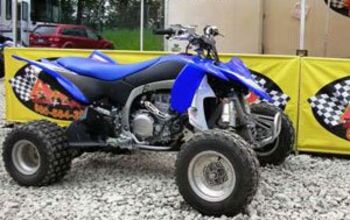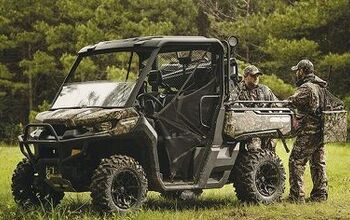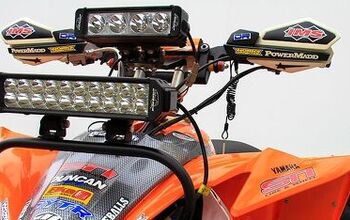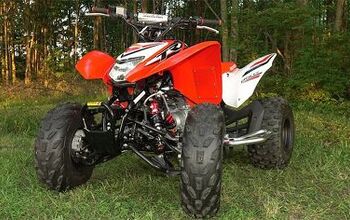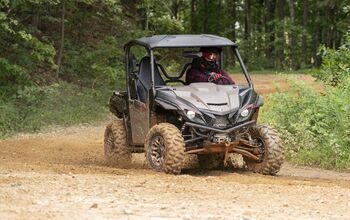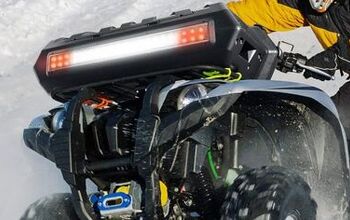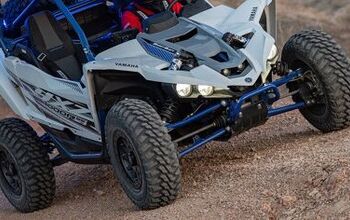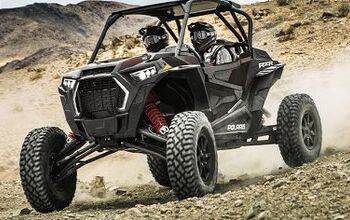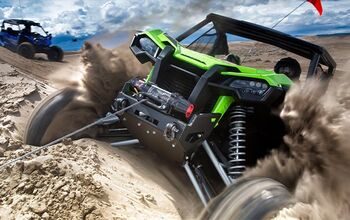TPR Yamaha YFZ450R Project
Tarantula Performance Racing’s latest project took Yamaha’s new YFZ450R and improved its track-ready prowess ten-fold.
TPR is well known for its part in producing the Spyder Quad, a tarantula-themed custom Suzuki LTR450 that made its debut with Douglas Wheel Technologies at the 2008 Indianapolis Dealer Expo. But the Spyder Quad, with all its industry-leading aftermarket additions, was destined to be a show piece that, to this day, has never hit the track.
This season, TPR took a different approach with the Tarantula Performance Racing project Yamaha YFZ450R. TPR built the YFZ-R to debut its new line of Race Safer Pro combination nerf bar and heel guards, but the TPR crew also wanted this quad to perform on the track and not just be another show queen.
Race Safer
You can’t race safe, but you can race safer. With that goal in mind, TPR designed its Race Safer Pro nerf bars with a bend and shape different from the 20-year-old flat design used by nearly every other nerf bar manufacturer.
The specially designed bend of the outer nerf bar creates a pocket to protect the rider’s feet and legs from a competitor’s wheels. The bend also works to keep the rider securely planted on the quad. Furthering that goal, the foot peg teeth are angled five degrees in toward the quad. This works in conjunction with the rider’s natural standing position to prevent a rider’s boot from sliding unintentionally towards the edge of the peg.
Brian Fredmonsky, the chief design engineer for TPR, said use of a longer foot peg with the new teeth angle still increases maneuverability without sacrificing sure footing.
“The Race Safer Pro nerf bars were built with one goal in mind, and that was to increase rider safety,” says Fredmonsky.
The TPR nerfs also address the most common complaint associated with Yamaha’s new YFZ450R. Most every YFZ-R owner looks to lower the stock foot peg position. The pegs on the TPR Race Safer Pro nerfs are one inch lower than stock. By lowering the pegs, riders can transition smoother and faster from sitting to standing for approaching track obstacles with a greater sense of where the frame may bottom out on the track.
Stitched and riveted nylon webbing stretches from the bar to the frame in both the heel guard and nerf bar positions to eliminate any gaps where the rider’s foot could slip through. The foot peg, nerf bar and netting are available in three color options: black, blue and gray, with the bar available in standard polished aluminum.
The TPR project YFZ-R also features TPR’s standard MX-Series front bumper, which includes the customizable and replaceable center insert. The removable insert can be completely customized to include a rider’s number, name, sponsor logo or other detailed image in a variety of colors.
Engine
In stock form, the YFZ450R has a restrictive intake and exhaust system limiting its power potential. Perry, Fla. based ATP Racing Engines signed on to give this quad a much needed horsepower boost.
On ATP’s dyno, the stock YFZ-R cranked out 44 horsepower. Not bad for the local tracks, but those numbers needed to increase to compete on a national level.
Mike Walker, the owner of ATP Racing Engines, quickly got to work on the YFZ-R head. ATP installed a 13.5:1 JE piston, ported and polished the cylinder head and put it through extensive flow testing. A competition Serdi valve job followed the flow testing to improve the valve seating. The quad retained its stock valves and seals, but ATP installed its own custom intake and exhaust camshafts.
According to Walker, his cams were re-degreed based on the initial dyno runs to provide more lift and duration to improve the YFZ-R’s overall power band.
“Most of your valve job work will improve your low-lift air flow numbers, which, will in turn translate to seat of the pants for a rider, better throttle response and initial hit, things of that nature,” says Walker.
To improve air flow, ATP installed Twin Air’s new Power Flow kit, which includes a replacement clamp-on style mount that eliminates the restrictive stock YFZ-R backfire screen. The kit included the filter and all necessary hardware.
ATP also installed a Motoworks full SR4 exhaust system and FMI controller to complement the engine work. The SR4 system consists of high quality components including T-304 stainless steel, pipe bends that are tig welded to perfection, extruded aluminum mounting brackets, a lightweight aluminum housing and a CNC machined flange.
ATP has a good working relationship with Motoworks, which sponsors their AMA ATV national riders. Walker’s extensive experience with the Motoworks FMI allowed him to easily dial the quad in on his dyno.
“The Motoworks tuner is a great tuner for your average guy,” Walker said. “It’s very easy to install and very easy to work with.”
Motoworks’ tuner uses CTL (Computer tuning logic) to optimize the air-to-fuel ratio across the entire RPM range. Motoworks’ engineering provides precision fuel settings and virtually unlimited tuning adjustments. The Motoworks FMI does not interfere with the stock ECU map and does not require complicated computer programs for adjustment.
The end result of the engine work was an impressive 20 percent power increase with the TPR project YFZ450R now cranking out 52 horsepower over a smooth power curve. Walker ripped a few test holeshots on the project quad himself at the Unadilla national track, where TPR met up with ATP to get the quad back this summer and continue the build.
“The power delivery is good on the bike,” Walker said. “You put a good rider on it, and you can win races with it.”
Suspension
The YFZ450R has great stock suspension, but the quad is still about an inch shy of the maximum 50-inch width permitted in the AMA ATV National Motocross Championship series.
So Tarantula Performance Racing partnered with ATV Four Play owner Tom Skladzien to widen the front end with a set of his championship winning MGC MX long-travel A-arms. The Wadsworth, Ohio based company had yet to design a set of their arms for the new Yamaha and built its first set for the TPR project YFZ450R.
Yamaha’s engineers, according to Skladzien, obviously put a lot of thought into designing the front end of the new YFZ-R with the increase in rake and narrow lower frame rail to improve cornering and bump steer. But you can always build a better mouse trap.
“We moved the shock location to offer a plusher ride and (riders) have the capabilities of changing caster and camber,” says Skladzien.
ATV Four Play’s A-arms use the same length shock as the stockers, which measure in at about 18.5 inches, but the arms increase the YFZR’s wheel travel to 10.5 inches from the stock limit of 9.8 inches.
Fox Racing Shox spent two weeks building a set of its Float X Evol front shocks for the ATV Four Play A-arms. The Float X Evol front shocks weigh in at a mere 4.6 pounds and slim down the TPR project YFZ450R. The Floats shave weight due to their elimination of the standard coil springs and instead feature a main air chamber for ride height settings and the Evol air chamber for bottom-out settings.
Also in the “suspension” department is a set of ATV Four Play’s Generation II Soft Bars. The pivoting handlebars work much like your typical quad shock. An allen-head bolt can be tightened or loosened to stiffen or soften the bar travel on each side. Four Play’s Progressive Dampening System ensures the resistance increases the more you tighten the allen head and as the bar moves through its travel – just like an ATV shock.
The Soft Bars, which feature a 12-degree bend similar to the CR high bend bar, are made of T-3 2024 aluminum tubing and billet T-6 6061 aluminum. The pivot areas are sealed, but one great aspect of the bars are grease zircs, which allow you to maintain the life of the pivot bushing.
TPR kept the stock aluminum swing arm and bolted on a Fox Podium X rear shock. The Podium X, like the front shocks, features dual-speed compression adjustments in addition to rebound and preload adjustments. RPM provided its Dominator II axle to widen the rear. RPM axles dominate the pro ranks in just about every series because of their strength. We’ve installed a number of axles during our years of riding and the RPM by far installed the easiest with the best fit and finish.
Controls, Tires and Wheels
A number of other performance parts were added to improve protection, handling, ergonomics and appearance.
B-Tek Performance provided another industry first for the TPR project YFZ450R with its single-bolt aluminum chassis SKID-EZ skid plate. The skid plate slides in place by hooking around the lower frame rails and is the first in the industry to use only one bolt to secure the skid to the quad. The single-bolt allows for quick installation and removal.
Bill Barth, owner and co-founder of B-Tek, said he has not experienced a single failure in six years of testing with A-class riders in New York.
“It’s made for the racer who has to wrench on his own machines,” says Barth. “The last thing you want is to have to fight with a skid plate.”
Also in the protection department, HMF Racing provided a set of its aluminum headlight deletes, which bolt into the headlight locations to protect the wiring tucked underneath the front plastic.
Cycra supported the project with a set of Stealth hand guards to deflect track roost. To improve grip comfort, Spider Grips sent several of its SLT and A3 ATV grips. Both products matched the Quadtech seat cover, which installed easily, features added grip and padding and is less likely to rip than the stock cover.
CV4 sent a set of its pure silicone coolant hoses, which improve coolant flow and hold up to hotter temperatures longer than the stock hoses. Galfer provided a set of stainless steel brake lines front and rear that further improved the quad’s already phenomenal braking response. Hinson Racing sponsored the project with a billet aluminum clutch cover and a Hinson clutch stack and springs.
Another new product included on the quad is the Douglas Wheel Technologies Champion in a Box wheel kit. The kit includes four pro-level, aluminum beadlock wheels with mud plugs, mounting hardware and a DWT hat. These wheels were introduced by DWT in 2009 and feature several improvements over its standard rims.
The rear G2 beadlock wheels are lighter than the DWT original Ultimate wheels. The rear wheels feature an improvement to the nut plate attachment and better fatigue resistance with their shot-peened wheel rings.
The Rok-N Lok front beadlock wheels feature a mesh-like screen in the center of the aluminum rim to keep stones and track debris out of the rotor and other hub parts. The Universal Built-in Rock Guard — as DWT calls it — works with all stock front hubs and most aftermarket hubs. Wrapping the wheels is a set of Maxxis’ proven soft compound Razr MX tires.
To improve the quad’s looks, Capital Powder Coating in Suffield, Ohio, treated a number of the quad’s parts to the company’s trademark “chameleonization” paint scheme. Capital gave the front A-arms a trick looking fade and added some shimmer and shine to other parts, including the DWT beadlock rings, front motor mounts and miscellaneous brackets. The end result is one fast-looking motocross quad sure to perform as good as it looks.
Stay tuned for a complete ride review and long-term evaluation of the TPR project YFZ450R right here on ATV.com. For a complete history of the project, you can check out TPR’s online blog, Quad Promotions, at http://tpr-atvs.blogspot.com/.
Related Reading
More by ATV.com Staff



